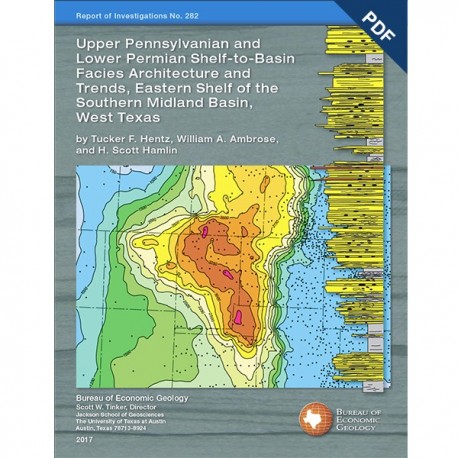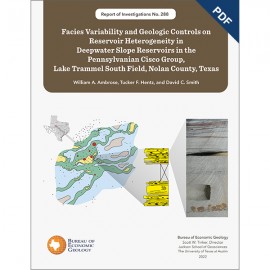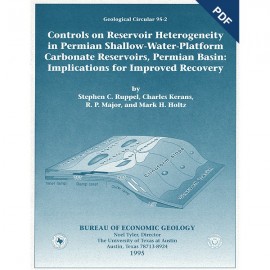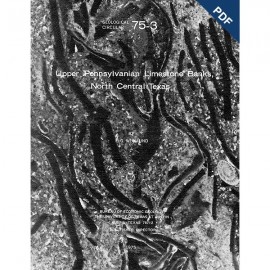Reports of Investigations
-
Books & Reports
- Reports of Investigations
- Guidebooks
- Udden Series
- Geological Circulars
- Down To Earth
- Atlases of Major Oil and Gas Reservoirs
- Texas Memorial Museum Publications
- Environmental Geologic Atlas of the Texas Coastal Zone
- Mineral Resource Circulars
- Other Reports
- Seminars and Workshops
- Handbooks
- Submerged Lands of Texas
- Symposia
- Annual Reports
- Open File Reports
-
Maps & Cross Sections
- Thematic Maps
- Miscellaneous Maps, Charts & Sections
- Geologic Atlas of Texas
- STATEMAP Project Maps
- Geologic Quadrangle Maps
- Cross Sections
- Highway Geology Map
- Energy and Mineral Resource Maps
- Shoreline Change and Other Posters
- Wilcox Group, East Texas, Geological / Hydrological Folios
- Bouguer Gravity Atlas of Texas
- River Basin Regional Studies
- Featured Maps
- Posters
- Teachers & the Public
-
Geological Society Publications
- Gulf Coast Association of Geological Societies
- Alabama Geological Society
- Austin Geological Society
- Corpus Christi Geological Society
- Houston Geological Society
- Lafayette Geological Society
- Mississippi Geological Society
- New Orleans Geological Society
- South Texas Geological Society
- GCS SEPM Publications
- Historic BEG & UT Series
Upper Pennsylvanian and Lower Permian Shelf-to-Basin Facies...Eastern Shelf...Midland Basin. Digital Download
RI0282D
For a print version: RI0282.
RI0282D. Upper Pennsylvanian and Lower Permian Shelf-to-Basin Facies Architecture and Trends, Eastern Shelf of the Southern Midland Basin, West Texas, by T. F. Hentz, W. A. Ambrose, and H. S. Hamlin. 68 p., 40 figs., 2 tables, 2 appendices, 1 plate and 1 file containing CD contents, 2017. doi.org/10.23867/RI0282D.
To purchase this publication in book format, please order RI0282. To purchase this publication on a flash drive, please order RI0282USB.
About This Publication
This report includes detailed descriptions and interpretations of whole cores representing key depositional intervals, 7 regional, shelf-to-basin, fold-out transects of all formation tops within the study area, and a downloadable spreadsheet of the more than 25 Canyon-Cisco formation tops of the 266 transect wells (2,247 total study wells).
ABSTRACT
Our study documents the shelf, shelf-edge, slope, and basin-floor depositional facies characteristics, stratigraphic variations, and sedimentation trends of the Missourian Canyon Group and Virgilian–Wolfcampian Cisco Group across the southern Eastern Shelf and the adjacent Midland Basin. The Canyon Group (base Palo Pinto Limestone to top Home Creek Limestone) consists of an aggradational carbonate bank succession having locally prominent reef facies. Similar reef facies continued to accumulate during early Cisco sedimentation. The bank/reef interval, largely equivalent in age to the Horseshoe Atoll complex, is as much as 1,540 ft (469 m) thick in northeastern Coke County and forms an irregular, but distinct, shelf margin throughout the eastern part of the study area. Reef buildups are generally aligned at the margin but also occur as local pinnacles in the platform interior. Canyon basin-floor facies are equivalent to the lower part of the Cline shale (“Wolfcamp D”) and consist primarily of dark, organic-rich (>2 percent organics) mudrocks.
The overlying Cisco section comprises a series of 13 mudrock, limestone, and sandstone cycles (top Home Creek Limestone to top Coleman Junction Limestone), correlated from outcrop, that collectively form a progradational succession extending from the eastern edge (Bunger Limestone) to the central part of the study area (Coleman Junction Limestone). The top of the Home Creek Limestone coincides with a regional downlap surface for the progradational Virgilian lower Cisco shelf strata. Progressive upward decrease in height of shelf-margin clinoforms indicates that accommodation had markedly decreased during deposition of the upper Cisco Group. The Pennsylvanian–Permian (Virgilian–Wolfcampian) boundary is at the top of the Cline shale in the basin and slope provinces and just above the Crystal Falls Limestone in the shelf area. The thickness of the Wolfcampian section is regionally consistent at the shelf (~700 to 850 ft [~213 to 259 m]), expands markedly basinward to as much as 3,500 ft (1,067 m) into a regional depocenter of high accommodation and high sediment influx associated with slope sedimentation, and then thins into the basin proper (to <500 ft [152 m]). Slope facies closest to Virgilian and lower Wolfcampian shelf margins are dominantly siliciclastic mudrocks and sandstone turbidite deposits in channel-levee complexes. The same facies of the upper Wolfcampian section are dominated by calcareous mudrocks and allochthonous carbonates as superimposed debris-flow deposits. The Wolfcampian (upper Cisco) basin system to the west comprises (1) primarily siliciclastic strata occurring as unconfined, thin turbidites and hemipelagic mudrocks in the lower part of the Wolfcampian succession and (2) carbonate debris-flow deposits and turbidites in the upper part. In contrast, the Virgilian (lower Cisco) basin succession constitutes mostly organic-rich mudrocks of the upper Cline shale.
Depositional cycles of the Virgilian and Wolfcampian (Cisco) shelf are dominantly transgressive limestones interstratified with highstand fluvial-deltaic and lowstand incised-valley-fill sandstones and mudrocks. Alternating thickened transgressive shelf-edge limestone systems and lowstand shelf-edge deltaic systems were deposited along the margin of the deepening basin. Shelf-edge systems of the 13 depositional cycles generally trend north–northeastward, subregionally coincide as stacked composite successions, and record periods of prolonged shelf-edge stability.
Keywords: Canyon Group, Cisco Group, Eastern Shelf, facies architecture, Lower Permian, Midland Basin, sedimentation trends, sequence stratigraphy, shelf and slope depositional facies, upper Missourian, Upper Pennsylvanian, Virgilian, Wolfcamp Formation, Wolfcampian
CONTENTS
Abstract
Introduction
Data Base and Methods
Geologic Setting
Previous Studies
Lithostratigraphy
Regional Chronostratigraphy
Depositional Systems
Canyon Group: Carbonate Reef-Bank and Shelf Systems
Core Data
Cisco Group: Shelf System
Core Data
Wiser Jacoby No. 14-C
Wiser Jacoby No. 3-B
Sun Armor-Caffey No. 2
Cisco Group: Shelf-Edge Bank System
Cisco Group: Slope System
Core Data
Texaco Sterling No. 1-D (Siliciclastic Slope Deposits)
Amerada Hess Robinson No. 1 (Carbonate Slope Deposits)
Amerada Hess Thompson No. C-1 (Carbonate Slope Deposits)
Canyon and Cisco Groups: Basin System
Cline Shale (Canyon and Lower Cisco Groups)
Wolfcampian Shale (Upper Cisco Group)
Core Data
Summary and Conclusions
Acknowledgments
References
Figures
1. Map of study area, showing distribution of correlated well logs and regional dip cross sections A-A’ through G-G’
2. Type stratigraphic column from the Midland Crap Shoot No. 1 well of southeastern Taylor County depicting most units correlated for this study
3. Locations of regional depositional-dip cross sections A-A’ through G-G’ in the study area
4. Location of Eastern Shelf and other regional tectonic elements of the Permian Basin in West Texas
5. Stratigraphic depositional-dip-oriented cross section generalized from regional cross section B-B’
6. Structure-contour map of the top of the Wolfcampian Series
7. Structure-contour map of the top of the Strawn Group
8. Isochore maps of the Canyon Group and lower Cisco Group limestone
9. Detailed well-log cross section of Canyon to lower Cisco carbonate reef-bank facies
10. Detailed well-log cross section of Canyon shelf limestones
11. Core description of the Sun Waide No. 1 well
12. Core photographs from the Sun Waide No. 1 well
13. Map of areal configuration of shelf-edge positions of the Cisco Group cycles
14. Detailed well-log cross section of the Cisco shelf system
15. Isochore map of the Wolfcampian upper Cisco Group
16. Core description of the Lower Hope sandstone and underlying truncated carbonate strata of the Blach Ranch Limestone in the Wiser Jacoby No. C-14 well
17. Core photographs from the Wiser Jacoby No. 14-C well
18. Core description of the Lower Hope sandstone in the Wiser Jacoby No. 3-B well
19. Core photographs from the Wiser Jacoby No. 3-B well
20. Core description of the Lower Hope sandstone and underlying truncated carbonate strata of the Blach Ranch Limestone in the Sun Armor-Caffey No. 2 well
21. Core photographs from the Sun Armor-Caffey No. 2 well
22. Detailed well-log cross section illustrating the basinward termination of the Gunsight to Blach Ranch shelf cycles
23. Detailed well-log cross section illustrating the basinward termination of the Breckenridge to Saddle Creek shelf cycles
24. Detailed well-log cross section illustrating the basinward termination of the Blach Ranch shelf cycle
25. Gross-sandstone map of post–Blach Ranch (Lower Hope sandstone) lowstand shelf-edge delta systems centered in Taylor, Jones, Nolan, and Fisher Counties, Texas
26. Detailed well-log cross section illustrating siliciclastic and carbonate slope facies equivalent to the Camp Colorado through Coleman Junction Limestone shelf cycles
27. Detailed well-log cross section illustrating siliciclastic and carbonate slope facies equivalent to the Sedwick through Coleman Junction Limestone shelf cycles
28. Core description of lower Wolfcamp slope channel-fill and levee deposits in the Texaco Sterling No. 1-D well from 7,764 to 7,864 ft
29. Core description of lower Wolfcamp slope channel-fill and levee deposits in the Texaco Sterling No. 1-D well from 7,460 to 7,501 ft
30. Core photographs of siliciclastic slope deposits in the Texaco Sterling No. 1-D well at 7,861.7 ft, 7,812.9 ft, and 7,834.8 ft44
31. Core photographs of siliciclastic slope deposits in the Texaco Sterling No. 1-D well at 7,480.3 ft, 7,481.4 ft, and 7,490.0 ft
32. Core description of deep-water slope carbonate debris-flow deposits in the Amerada Hess Robinson No. 1 well
33. Core photographs of deep-water carbonate debris-flow deposits in the Amerada Hess Robinson No. 1 well
34. Core description of deep-water slope carbonate debris-flow deposits in the Amerada Hess Thompson No. C-1 well
35. Core photographs of deep-water carbonate debris-flow deposits in the Amerada Hess Thompson No. C-1 well
36. Detailed well-log cross section illustrating regional similarity in the well-log expression of the Upper Pennsylvanian Cline shale
37. Isochore map of the Upper Pennsylvanian portion of the study interval (top of Strawn limestone facies to top of Pennsylvanian System)
38. Core description of lower Wolfcampian distal slope to basin-floor deposits in the Santa Fe Powell Ranch No. 3 well
39. Core photographs of distal slope to basin-floor deposits in the Santa Fe Powell Ranch No. 3 well
40. Schematic composite maps of Cisco Group and Canyon Group depositional trends of the southern part of the Eastern Shelf
Tables
1. Cores used in the study
2. Correlation of sequences, systems tracts, and major chronostratigraphic surfaces with subsurface lithostratigraphic names of the Eastern Shelf
Appendices
1. Identification information for all 266 study wells
2. Identification information and depths of formation tops for all 266 study wells
Plate 1. Regional depositional-dip-oriented cross sections A-A’ through G-G’ extending east–west from the Eastern Shelf across the Midland Basin
Citation
Hentz, T. F., Ambrose, W. A., and Hamlin, H. S., 2017, Upper Pennsylvanian and Lower Permian Shelf-to-Basin Facies Architecture and Trends, Eastern Shelf of the Southern Midland Basin, West Texas: The University of Texas at Austin, Bureau of Economic Geology, Report of Investigations No. 282, 68 p. doi.org/10.23867/RI0282D.






